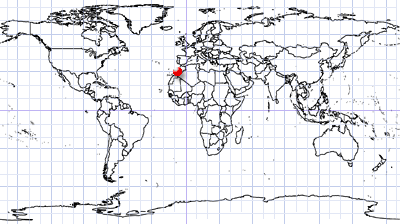
Formed lakes in Morocco
Southern Morocco
Dates of acquisition:
• October 09th, 2024 | 11:12:52 UTC
• October 12th, 2024 | 11:23:28 UTC
• October 13th, 2023 | 11:23:32 UTC
Sensor: Sentinel-2 L2A
Coordinates: ca. 29.8°N, 6.5°W; 28.4°N, 9.2°W
The region of southern of Morocco bordering Algeria and Western Sahara is one of the driest in the world, and it rarely rains in early autumn.
This year, however, there were heavy rains at the beginning and especially at the end of September. On two days in September, the 20th and 21st, more than 100 litres of rain per square metre fell in some desert areas (Figure 1).
Streams of water broke through the sands of the Sahara and formed entire lakes in the lowlands.
Such downpours are known as extratropical storms. In this case, the air can hold more moisture, leading to increased evaporation over the ocean and an increase in precipitation. It is thought that this phenomenon has not been observed to the same extent in the last 30-50 years, as it has been in 2024.
In fact, all available high-resolution Landsat satellite images since 1972 confirm this assumption.
Lake Iriqui (بحيرة إيريكي), for example, was always dry during this period. It began to fill on 8 September 2024 and reached its maximum size of about 81 km2 within a month.
We can therefore say that this is the first time in the history of high-resolution satellite observations, that we have seen the image of a water filled Lake Iriqui (Figure 2). The yellow lines and spots in the centre of the lake are the tops of the dunes rising out of the water. Figure 3 shows an image of the lake in the thermal and radio wave ranges.
Another example is shown in Figure 4. Here, south of the settlement of Touizgui (تويزݣي , a small town in the province of Assa-Zag in the region of Guelmim-Oued Noun), there is a dry bed of the Wadi Tighzert (وادي تيغزرت), which is adjoined by a shallow basin bordered by a mountain range to the south. This basin, which has remained dry for more than 50 years of observation, is now filled with water heavily sedimented with sand and brown mud. This is the first time we have seen it in satellite data in this state. The area of the resulting reservoir is about 20 km2.
In this area, the valley of the river Draa (درعَا), the longest river in Morocco at 1150 km, there are many ancient sites with rock paintings of animals that indicate that the climate here was much wetter some 7-10 thousand years ago. The landscapes were different from today and the vegetation was lush and green.
A small statue of a woman was also found here, aged between 300 thousand and 500 thousand years, making it the earliest monument of artistic creativity known to science.







